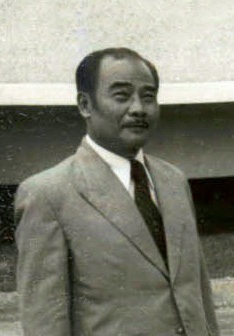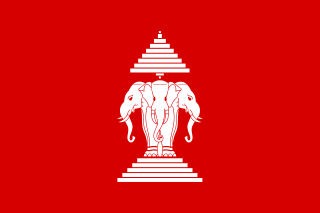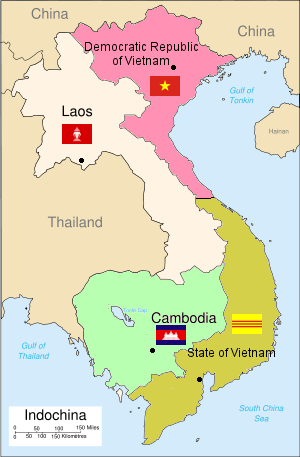The Vientiane Treaty was a cease-fire agreement between the two warring factions in the Laotian Civil War (the Kingdom of Laos and the communist Pathet Lao), signed in Vientiane (the capital of Laos), on 21 February 1973.
The Vientiane Treaty was in some sense a corollary to the Paris Peace Accords, signed the month before, which had ended U.S. involvement in the Vietnam War. Just as the Paris Accords had mandated the withdrawal of all US forces in Vietnam, the Vientiane Treaty called for the removal from Laos of all foreign forces allied to each side.
Under the terms of the treaty, a new coalition government was to be created; security in major cities (such as Vientiane) was to be undertaken by joint forces from both sides.
There were no outside guarantees to the terms, as the agreement was only between the Lao factions; the ICC (which had overseen the 1954 Geneva Accords ending the First Indochina War) was more powerless than before to monitor compliance.
The coalition government envisaged by the treaty did not long outlast it; as with the treaty itself, events in Laos emulated those in Vietnam. Shortly after the fall of the South Vietnamese government on 30 April 1975, the Pathet Lao took over Laos on 15 August 1975.

Laos, officially the Lao People's Democratic Republic, is the only landlocked country in Southeast Asia. At the heart of the Indochinese Peninsula, Laos is bordered by Myanmar and China to the northwest, Vietnam to the east, Cambodia to the southeast, and Thailand to the west and southwest. Its capital and largest city is Vientiane.

Evidence of modern human presence in the northern and central highlands of Indochina, which constitute the territories of the modern Laotian nation-state, dates back to the Lower Paleolithic. These earliest human migrants are Australo-Melanesians—associated with the Hoabinhian culture—and have populated the highlands and the interior, less accessible regions of Laos and all of Southeast Asia to this day. The subsequent Austroasiatic and Austronesian marine migration waves affected landlocked Laos only marginally, and direct Chinese and Indian cultural contact had a greater impact on the country.

Prince Souphanouvong, nicknamed the Red Prince, was along with his half-brother Prince Souvanna Phouma and Prince Boun Oum of Champasak, one of the "Three Princes" who represented respectively the communist (pro-Vietnam), neutralist and royalist political factions in Laos. He was the President of Laos from December 1975 to October 1986.

The Kingdom of Laos was the form of government in Laos from 1947 to 1975. Located in Southeast Asia at the heart of the Indochinese Peninsula, it was bordered by Burma and China to the northwest, North Vietnam to the east, Cambodia to the southeast, and Thailand to the west and southwest. The country was governed as a constitutional monarchy beginning with its independence on 9 November 1953. It survived until December 1975, when its last king, Sisavang Vatthana, surrendered the throne to the Pathet Lao during the civil war in Laos, who abolished the monarchy in favour of a Marxist–Leninist state called the Lao People's Democratic Republic, which has controlled Laos ever since.

Sisavang Vatthana or sometimes Savang Vatthana was the last king of the Kingdom of Laos and the 6th Prime Minister of Laos serving from 29 October to 21 November 1951. He ruled from 1959 after his father's death until his forced abdication in 1975. His rule ended with the takeover by the Pathet Lao in 1975, after which he and his family were sent to a re-education camp by the new government.

The Pathet Lao, officially the Lao People's Liberation Army, was a communist political movement and organization in Laos, formed in the mid-20th century. The group ultimately conquered the entire country of Laos in 1975, after the Laotian Civil War. The Pathet Lao were always closely associated and dependent on Vietnamese communists and North Vietnam since their foundation, with the group being established after advice from Hanoi to create a Laotian counterpart of the Viet Minh later Viet Cong. During the civil war, it was effectively organised, equipped and even led by the People's Army of Vietnam (PAVN). They fought against the anti-communist forces in the Vietnam War. Eventually, the term became the generic name for Laotian communists. Under orders from Mao Zedong, the People's Liberation Army provided 115,000 guns, 920,000 grenades and 170 million bullets, and trained more than 700 of its military officers.

Phoumi Vongvichit was a leading figure of the Pathet Lao and an elder statesman of the Lao People's Democratic Republic.

The Laotian Civil War was waged between the Communist Pathet Lao and the Royal Lao Government from 23 May 1959 to 2 December 1975. The Kingdom of Laos was a covert theater during the Vietnam War with both sides receiving heavy external support in a proxy war between the global Cold War superpowers. The fighting also involved the North Vietnamese, South Vietnamese, American and Thai armies, both directly and through irregular proxies. The war is known as the Secret War among the American CIA Special Activities Center, and Hmong and Mien veterans of the conflict.

The Geneva Conference was intended to settle outstanding issues resulting from the Korean War and the First Indochina War and involved several nations. It took place in Geneva, Switzerland, from 26 April to 20 July 1954. The part of the conference on the Korean question ended without adopting any declarations or proposals and so is generally considered less relevant. On the other hand, the Geneva Accords that dealt with the dismantling of French Indochina proved to have long-lasting repercussions. The crumbling of the French colonial empire in Southeast Asia led to the formation of the states of the Democratic Republic of Vietnam, the State of Vietnam, the Kingdom of Cambodia, and the Kingdom of Laos. Three agreements about French Indochina, covering Cambodia, Laos, and Vietnam, were signed on 21 July 1954 and took effect two days later.

This article details the history of Laos from 1945 to the present.

The French protectorate of Laos was a French protectorate in Southeast Asia of what is today Laos between 1893 and 1953—with a brief interregnum as a Japanese puppet state in 1945—which constituted part of French Indochina. It was established over the Siamese vassal, the Kingdom of Luang Phrabang, following the Franco-Siamese crisis of 1893. It was integrated into French Indochina and in the following years further Siamese vassals, the Principality of Phuan and Kingdom of Champasak, were annexed into it in 1899 and 1904, respectively.
The United States Air Force (USAF) deployed combat aircraft to Thailand from 1960 to 1975 during the Vietnam War. Today, US military units train with other Asian militaries in Thailand. Royal Thai Air Force Bases are an important element in the Pentagon's "forward positioning" strategy.
The International Agreement on the Neutrality of Laos is an international agreement signed in Geneva on July 23, 1962 between 14 states, including Laos, as a result of the International Conference on the Settlement of the Laotian Question, which lasted from May 16, 1961 to July 23, 1962.
The Programs Evaluation Office was a covert paramilitary mission to the Kingdom of Laos, established on 13 December 1955 by the United States Department of Defense. The 23 July 1962 International Agreement on the Neutrality of Laos would cause it to be shut down in September 1962. It would be succeeded by the Requirements Office.

Operation Barrel Roll was a covert U.S. Air Force 2nd Air Division and U.S. Navy Task Force 77, interdiction and close air support campaign conducted in the Kingdom of Laos between 14 December 1964 and 29 March 1973 concurrent with the Vietnam War. The operation resulted in 260 million bombs being dropped on Laos.

CIA activities in Laos started in the 1950s. In 1959, U.S. Special Operations Forces began to train some Laotian soldiers in unconventional warfare techniques as early as the fall of 1959 under the code name "Erawan". Under this code name, General Vang Pao, who served the royal Lao family, recruited and trained his Hmong and Iu-Mien soldiers. The Hmong and Iu-Mien were targeted as allies after President John F. Kennedy, who refused to send more American soldiers to battle in Southeast Asia, took office. Instead, he called the CIA to use its tribal forces in Laos and "make every possible effort to launch guerrilla operations in North Vietnam with its Asian recruits." General Vang Pao then recruited and trained his Hmong soldiers to ally with the CIA and fight against North Vietnam. The CIA itself claims that the CIA air operations in Laos from 1955 to 1974 were the "largest paramilitary operations ever undertaken by the CIA."

North Vietnam supported the Pathet Lao to fight against the Kingdom of Laos between 1958 and 1959. Control over Laos allowed for the eventual construction of the Ho Chi Minh Trail that would serve as the main supply route for enhanced NLF and NVA activities in the Republic of Vietnam. As such, the support for Pathet Lao to fight against Kingdom of Laos by North Vietnam would prove decisive in the eventual communist victory over South Vietnam in 1975 as the South Vietnamese and American forces could have prevented any NVA and NLF deployment and resupply if these only happened over the 17th Parallel, also known as the Demilitarized Zone (DMZ), a narrow strip of land between North and South Vietnam that was closely guarded by both sides. It also helped the Pathet Lao win against the Kingdom of Laos, even though the Kingdom of Laos had American support.
The Military history of Laos has been dominated by struggles against stronger neighbours, primarily Thailand and Vietnam, from at least the 18th century.
The 1964 Laotian coups were two attempted coup d'etats against the Royal Lao Government. The 18 April 1964 coup was notable for being committed by the policemen of the Directorate of National Coordination. Although successful, it was overturned five days later by U.S. Ambassador Leonard Unger. In its wake, Neutralist Prime Minister Souvanna Phouma forged a fragile coalition with the Pathet Lao communists. On 4 August 1964, Defense Minister Phoumi Nosavan attempted to take over Vientiane with a training battalion. This coup was quickly crushed by the local Royal Lao Army troops, as the police sat out the conflict.

Kou Voravong was a Laotian politician. He was part of the anti-Japanese resistance leading group during the Second World War and then anti-Lao Issara (ລາວອິດສລະ) in the post-war period. Throughout his career, from 1941 to 1954, he has been District Chief, Province Governor, member of the Lao National Assembly, and Royal Lao Government Minister.